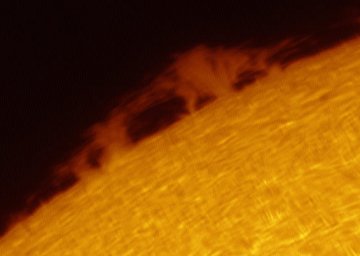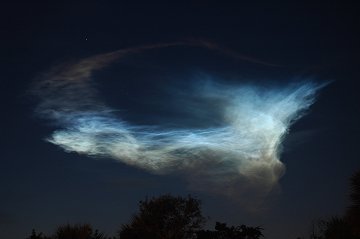 Where's Saturn? Is that a UFO--or the ISS? What's the name of that star? Get the answers from mySKY--a fun new astronomy helper from Meade. Where's Saturn? Is that a UFO--or the ISS? What's the name of that star? Get the answers from mySKY--a fun new astronomy helper from Meade. ALERT: Tiny sunspot 966 is suddenly crackling with C-class solar flares. Amateur astronomers with solar telescopes may wish to monitor developments. MARS IN THE MORNING: Mars, the crescent Moon and the Pleiades star cluster have gathered to form a pretty triangle in the sky. Just one problem: You need to rise at the crack of dawn to see it. Set your alarm for 4:00 am Tuesday morning. The view out your eastern window may be worth waking up for: sky map. SOLAR NEPHELOCOCCYGIA: There's a word for finding shapes in clouds: nephelococcygia. Now we need a word for finding shapes in prominences. "Yesterday I was looking at the Sun through my SolarMax90," says Larry Alvarez of Flower Mound, Texas, "and I spotted what looked like a T-Rex eating its breakfast." He snapped this picture: 
Half a world away in Singapore, Ng Wee Nghee photographed the same prominence and deemed it "a Blooming Mushroom." These flights of fancy may be explained by the fact that solar prominences are clouds--clouds of hydrogen held up and twisted into strange shapes by solar magnetic force fields. Solar nephelococcygia? It's in the eye of the beholder. more images: from Emiel Veldhuis of Zwolle, the Netherlands; from Britta Suhre of Dortmund, Germany; from P-M Hedén of Vallentuna, Sweden; from Monty Leventhal of Sydney, Australia; from Pavol Rapavy of Rimavska Sobota, Slovakia; from Erika Rix of Zanesville, Ohio; from Steve Wainwright of West Wales UK. MARS ROCKET TRAIL: Phoenix has left Earth. The robotic Mars lander began its 9 month journey to the Red Planet Saturday morning, Aug. 4, at 5:29 am EDT when a Delta II rocket blasted off from Cape Canaveral. Signals received by the Deep Space Network indicate the craft is on course and in good condition: status reports. The pre-dawn launch wowed onlookers, but it wasn't only the rocket that impressed. The Delta II's exhaust put on a show of its own: 
James Bjornbak snapped this photo from the Kennedy Space Center. "I used my Nikon D70 to make a 10-second exposure," he says. The glowing loop is, essentially, a man-made noctilucent cloud (NLC). Tiny crystals of ice and other particles in the rocket's exhaust caught the rays of the early morning sun and lit up dramatically against the deep-twilight sky. more images: from Jeffrey Berkes of Fort Lauderdale, Florida; from Sid Leach of Cocoa Beach, Florida; from William Wilson of Titusville, Florida; from Jerry W. Kinnamon of Zephyrhills, Florida; from Dimitar Boyadjiev and Kazumasa Imai at Cape Canaveral, Florida; from Georgina Love of Fort Pierce, Florida. A similar display was seen in June when space shuttle Atlantis lifted off before sunrise to visit the International Space Station. While the formation of these man-made clouds is understood, the origin of natural NLCs, which can gather over high latitudes without any rocket to prompt them, remains a mystery. NASA's AIM spacecraft is in orbit now to investigate. .2007 Noctilucent Cloud Gallery
[Night-Sky Cameras] ["Noctilucent Cloud"--the song] | 
